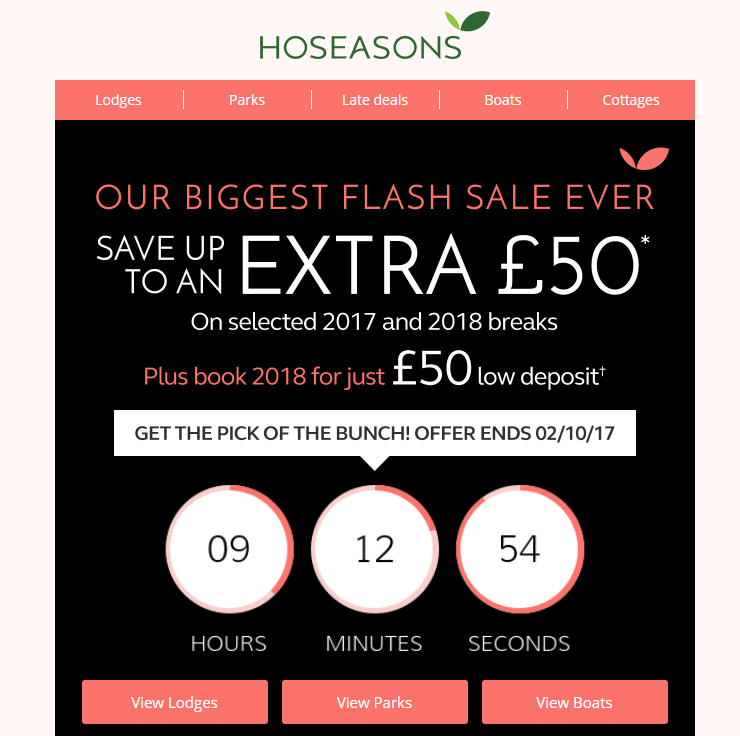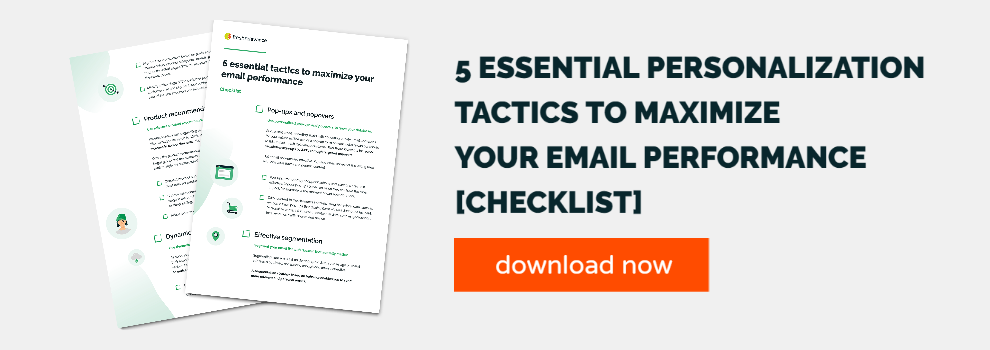Email marketing might not be as hip as some of the newer tools in a marketer’s toolbox, but it continues to be one of the highest-converting marketing channels. In fact, research has shown that every dollar invested in email generates an average return of $42. However, this doesn’t give us license to spray and pray. Over 306 billion emails are sent each day, which means going the extra mile if you want to catch your shoppers’ attention.
Email personalization is a tried and tested way to boost open rates, click-throughs and conversions. But what exactly does it entail?
Email personalization is when email marketers engage subscribers with targeted email campaigns based on data and information they have about them. Entry level email personalization could be adding your customer’s name to the subject line, for example. But to really stand out in your customers’ crowded inboxes and provide a truly tailored experience, you’ll need to take your email personalization to the next level with tactics such as dynamic content, personalized product recommendations and smart segmentation.
Read on for 5 steps to becoming an email personalization pro (with examples and best practices to really help your emails shine).
1. Meaningful segmentation
There was a time when segmenting by age, gender or postal address was considered the height of personalization. But with today’s technology and the amount of data available at our fingertips, segmenting by demographic data is outdated, not specific enough and often ineffective. Keep your emails relevant and personalized with a segmentation strategy based on preferences and behavior instead.
Try segmenting customers based on favorite colors, product categories, brands, purchased products and frequently visited pages, for example.
Segmenting customers this way means shoppers benefit from the most useful information, while marketers generate more revenue by targeting customers with a propensity to convert. Win win.
Best practice tip: When retargeting shoppers, make sure you set up rules to ensure that customers are not shown content promoting something they have already bought. Collect and coordinate data from all your customer touchpoints in real time, so a shopper can be removed from a segment as soon as they have converted.
Learn more: 9 types of segmentation you should be using to drive conversions.
2. Personalized product recommendations
Not all product recommendations are personalized, and while there’s value in recommendations based on bestsellers and items on sale, personalized product recommendations have greater impact on email revenue. Here are the stats to prove it. Fresh Relevance user Vision Direct increased click-throughs by 557% with personalized product recommendations.
Try suggesting products that the customer has frequently browsed or purchased or show them which products other shoppers like them purchase.

Rip Curl’s use of personalized product recommendations in their cart abandonment emails enables them to showcase products that were bought by similar customers, frequently browsed items, and exciting new Rip Curl lines.
Best practice tip: Often, companies’ product recommendations strategies aren’t in line with both the target group and the business objectives. For example, products with a low profit margin are shown, which can lead to more revenue but little profit. Make sure you display relevant products for each customer whilst adapting recommendations to your business objectives.
Learn more:
The Complete Guide to Personalized Product Recommendations
Rip Curl sales swell by more than 10% with ecommerce personalization
3. Dynamic images
The hero banner is prime email real estate. It’s the first impression you make on your email recipient, so make sure you’re using it wisely. Combine dynamic content with behavioral and contextual data so you can respond to the shopper’s interests and brand preferences as well as location, season and weather.
With dynamic images generated at the time of open, you can also encourage urgency with current stock levels, popularity messaging, and countdown timers.

Hoeseasons‘ countdown timer generates urgency and draws our attention to their flash sale. The timer makes it clear that if we don’t act fast we’re going to miss out on that extra £50 saving.
Best practice tip: Steer clear of spam filters by avoiding image-heavy emails. To make sure your email lands safely in a customer’s inbox, it’s advisable to strike a balance between visual content and engaging text. Recommendations for the ideal text-to-image ratio vary between 80:20 and 50:50.
Learn more:
How to make the most of dynamic images in emails
4. Triggered emails
Triggered emails are a proven way to increase conversion rates with timely and relevant messages based on customer behavior.
Cart abandonment is a popular and effective triggered email tactic, but don’t stop there. Engage your shoppers with other forms of triggered emails, such as:
- browse abandonment emails
- form abandonment emails
- post-purchase emails
- replenishment emails

Whistlefish have added a ‘why shop with Whistlefish’ section to entice cart abandoners back by highlighting the positive shopping experience they offer.
Best practice tip: When it comes to shopping abandonment, it’s often a good idea to send more than one email reminder. Consumers are increasingly distracted and frequently switch between web pages, tabs, and devices. A well-timed second or third reminder could be what it takes to bring these shoppers back to your website.
Learn more:
5 steps to triggered emails that generate revenue
How Maplin generated a 6.2% sales uplift with shopping recovery emails
5. Testing, measuring and optimization
To get the most out of email personalization, make sure you test, measure and optimize campaigns on an ongoing basis.
Set up split testing and control groups to work out how a trigger campaign or piece of content is contributing to engagement and sales and fine-tune as you go.
Best practice tip: When performing a test, it’s important to set KPIs and know which metric you want to focus on. You can then decide on the winning variation using real data.
Learn more:
What are triggered emails and how to optimize them
How to avoid set and forget personalization blunders
How to work with siloed data
50% of marketers claim to be hampered by siloed data and it’s a key blocker in executing a successful personalization strategy.
If you’re working with siloed data, it’s likely you have one set of data in your ESP (which can be used for email personalization) and separate data in your eCommerce system (which can’t be used).
There are a couple of ways to bridge the gap.
1. The standard way to integrate data is to build custom processes, such as scheduling a data extraction from the eCommerce system overnight, copying it via FTP, cleaning it, and loading it into the ESP. However, configuring and managing this sort of process is labor-intensive and can be expensive to design and setup.
2. An easier, more effective and often much cheaper way is using a Real-Time Marketing System (RTMS), such as Fresh Relevance. These systems automatically take eCommerce data and load it into your ESP, using a combination of screen scraping and API calls. The data is available in real-time, which allows you to be more reactive when marketing.
Learn more: 6 ways to drive more email revenue with Fresh Relevance.
Now that you’ve read our 5 steps to becoming an email personalization pro, take a look at our checklist with 5 essential personalization tactics to maximize your email performance.






